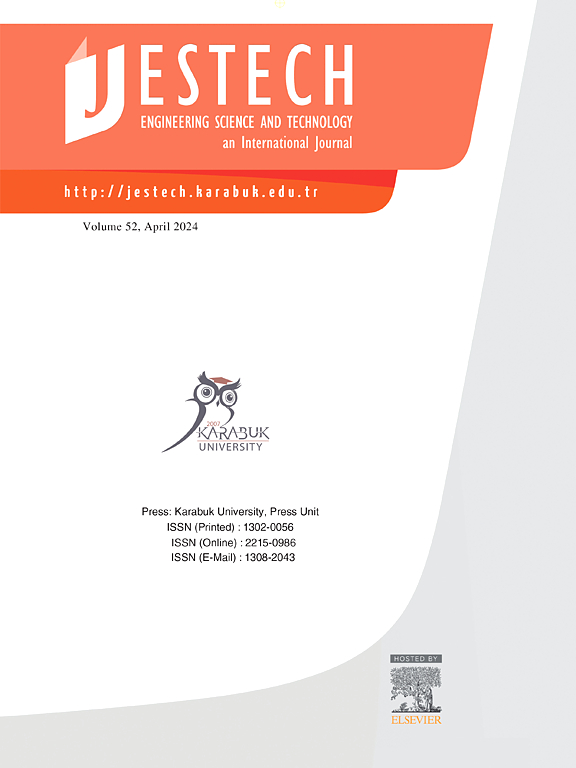基于深度混沌莱维瞪羚优化的太阳能水电解绿色制氢模型
IF 5.1
2区 工程技术
Q1 ENGINEERING, MULTIDISCIPLINARY
Engineering Science and Technology-An International Journal-Jestech
Pub Date : 2024-11-11
DOI:10.1016/j.jestch.2024.101874
引用次数: 0
摘要
本文介绍了一种深度学习(DL)模型,旨在利用太阳能水电解槽生产绿色氢气。该模型分四个阶段运行,从分析太阳辐射数据集开始,最终预测绿色制氢。该模型采用了一种名为 DeepGaz 的新型混合模型,用于预测制氢所需的太阳能。DeepGaz 结合了瞪羚优化算法(CGOA)的新混沌-莱维变体和用于超参数优化的递归神经网络(RNN/LSTM)。为了验证所提模型的性能,CGOA 首先在 CEC2022 基准问题上进行了测试,并与其他先进的元启发式算法进行了比较,其准确性通过 Wilcoxon 秩和统计分析得到了进一步确认。随后,DeepGaz 被应用于基于太阳能的绿色氢气数据集,优化了四个月内从夏威夷 HI-SEAS 气象站收集的太阳辐射、温度、风向和风速等关键参数。结果表明,DeepGaz 显著改善了预测过程,在四个月的研究中,平均日产氢量达到 15.5199 公斤/天。该模型在预测绿色氢气生产方面表现出了强大的潜力,在计算时间、收敛稳定性和整体求解精度方面都非常出色。本文章由计算机程序翻译,如有差异,请以英文原文为准。
A green hydrogen production model from solar powered water electrolyze based on deep chaotic Lévy gazelle optimization
This paper presents a Deep Learning (DL) model designed for green hydrogen production using a solar-powered water electrolyzer. The model operates in four phases, beginning with the analysis of a solar radiation dataset and culminating in the prediction of green hydrogen production. A novel hybrid model, termed DeepGaz, is introduced to predict the solar energy required for hydrogen production. DeepGaz combines a new Chaotic-Lévy variant of the gazelle optimization algorithm (CGOA) with a recurrent neural network (RNN/LSTM) for hyperparameter optimization. To validate the performance of the proposed model, CGOA is first tested on the CEC2022 benchmark problems and compared with other advanced metaheuristic algorithms, with its accuracy further confirmed using Wilcoxon’s rank-sum statistical analysis. Subsequently, DeepGaz is applied to a solar-based green hydrogen dataset, optimizing key parameters such as solar radiation, temperature, wind direction, and speed, collected from the HI-SEAS weather station in Hawaii over a four-month period. The results show that DeepGaz significantly improves the prediction process, achieving an average daily hydrogen production of 15.5199 kg/day during the four-month study. The model exhibits strong potential in predicting green hydrogen production, excelling in computational time, convergence stability, and overall solution accuracy.
求助全文
通过发布文献求助,成功后即可免费获取论文全文。
去求助
来源期刊

Engineering Science and Technology-An International Journal-Jestech
Materials Science-Electronic, Optical and Magnetic Materials
CiteScore
11.20
自引率
3.50%
发文量
153
审稿时长
22 days
期刊介绍:
Engineering Science and Technology, an International Journal (JESTECH) (formerly Technology), a peer-reviewed quarterly engineering journal, publishes both theoretical and experimental high quality papers of permanent interest, not previously published in journals, in the field of engineering and applied science which aims to promote the theory and practice of technology and engineering. In addition to peer-reviewed original research papers, the Editorial Board welcomes original research reports, state-of-the-art reviews and communications in the broadly defined field of engineering science and technology.
The scope of JESTECH includes a wide spectrum of subjects including:
-Electrical/Electronics and Computer Engineering (Biomedical Engineering and Instrumentation; Coding, Cryptography, and Information Protection; Communications, Networks, Mobile Computing and Distributed Systems; Compilers and Operating Systems; Computer Architecture, Parallel Processing, and Dependability; Computer Vision and Robotics; Control Theory; Electromagnetic Waves, Microwave Techniques and Antennas; Embedded Systems; Integrated Circuits, VLSI Design, Testing, and CAD; Microelectromechanical Systems; Microelectronics, and Electronic Devices and Circuits; Power, Energy and Energy Conversion Systems; Signal, Image, and Speech Processing)
-Mechanical and Civil Engineering (Automotive Technologies; Biomechanics; Construction Materials; Design and Manufacturing; Dynamics and Control; Energy Generation, Utilization, Conversion, and Storage; Fluid Mechanics and Hydraulics; Heat and Mass Transfer; Micro-Nano Sciences; Renewable and Sustainable Energy Technologies; Robotics and Mechatronics; Solid Mechanics and Structure; Thermal Sciences)
-Metallurgical and Materials Engineering (Advanced Materials Science; Biomaterials; Ceramic and Inorgnanic Materials; Electronic-Magnetic Materials; Energy and Environment; Materials Characterizastion; Metallurgy; Polymers and Nanocomposites)
 求助内容:
求助内容: 应助结果提醒方式:
应助结果提醒方式:


